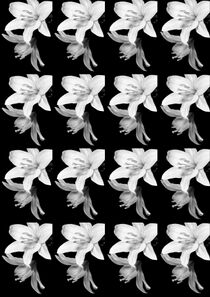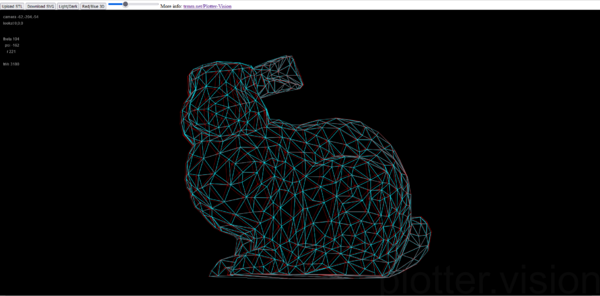User:Thijshijsijsjss/PTMoMNBM/Pen Plotted 3D Movie: Difference between revisions
(Create page with template) |
(Fill in part of the template) |
||
| (One intermediate revision by the same user not shown) | |||
| Line 1: | Line 1: | ||
'''What is it?''' | '''What is it?''' | ||
This project concerns a 3D movie that consists of non-digital, all-pen plotted frames: a large 'flipbook' with offset images that are plotted in red / cyan, so that a 3D effect emerges when one looks at the moving frames with 3D glasses. | |||
The movie conerns a yet to be decided on topic. It will most likely last no longer than 5 seconds (assuming 'intended' revolution speed of flipbook). | |||
The movie is then accompanied by a screening | |||
'''Why make it?''' | '''Why make it?''' | ||
'''Workflow''' | '''Workflow and Timetable''' | ||
TBD | |||
'''Rapid prototypes''' | |||
''' | |||
'''Previous practice''' | '''Previous practice''' | ||
This example project is not mine, but Alessia's. I think it conveys the potential in pen plotted animations well: | |||
{|align=center | |||
|[[File:97-112.jpg|frameless|210px]] | |||
|<img src="https://media.giphy.com/media/v1.Y2lkPTc5MGI3NjExbjk3OTUyeGkzcmJ5dThkbzE1bWZkYmVucG1qOGFycDg2anNxMXFwbSZlcD12MV9pbnRlcm5hbF9naWZfYnlfaWQmY3Q9Zw/ofBdDrTAUuCXNkT6lr/giphy.gif"style= width:410px;> | |||
|<img src="https://media.giphy.com/media/v1.Y2lkPTc5MGI3NjExdWVxd2QwdTJzZWZvdWU3am1vdHpzb3BvZmxsMDloYXQ4YjFic3o1ZyZlcD12MV9pbnRlcm5hbF9naWZfYnlfaWQmY3Q9Zw/6aFzGnpryqRkBMBd7Q/giphy-downsized-large.gif"style= width:300px;> | |||
|} | |||
[[User:Alessia/Pen_plotter_flipbooks|Find Alessia's dedicated project page on pen plotted flipbooks here]] | |||
'''Relation to a wider context''' | |||
3D film obviously has a long history. There have been many attempts to simulate 3D effects, one of which being the flimsical red/blue glasses. A nice entry point into some more experimental 3D effect is [https://www.youtube.com/watch?v=Q-v4LsbFc5c this Tom Scott video on the Pulfrich effect]. | |||
Flipbooks, as well, have a long history. In our case, the mutoscope might be of interest. | |||
With Joseph, I looked at [https://plotter.vision/ a project that projects 3D renders to 2D vectors]. This is part of a larger research endeavor of ours to create software for SVG to HPGL conversion. | |||
[[File:Plotter-vision-web.png|600px|thumb|center|Screenshot of [https://plotter.vision/ plotter vision], with the red / blue 3D mode]] | |||
{|align=center | |||
|{{youtube|KYMT7x2QsYA}} | |||
|{{youtube|5uc1-1-2les}} | |||
<!-- |{{youtube|4aTur21yims}} --> | |||
|- | |||
|{{youtube|MEeu2RSr4js}} | |||
|{{youtube|jP2yy6fUR_w}} | |||
|} | |||
'''Choices made''' | '''Choices made''' | ||
The most impactful decision for this project is whether or not the frames should be digital or not. Physical frames mean: | |||
* a physical device is needed to show the animation | |||
* the 3D effect will be more difficult to convey, as the frame transitions aren't as smooth as for digital frames | |||
* the length of the film is greatly limited (to that of the carousel that holds the frames) | |||
* it is a | |||
For these reasons, a similar project but with digitized pen plotted frames should be considered also. However, there is an important reason to go for physical frames: the nature of pen plotting. Part of the allure of these devices is their (performance through their) mechanical nature. A physical screening can be an extension of this. | |||
Latest revision as of 11:13, 21 June 2024
What is it?
This project concerns a 3D movie that consists of non-digital, all-pen plotted frames: a large 'flipbook' with offset images that are plotted in red / cyan, so that a 3D effect emerges when one looks at the moving frames with 3D glasses. The movie conerns a yet to be decided on topic. It will most likely last no longer than 5 seconds (assuming 'intended' revolution speed of flipbook). The movie is then accompanied by a screening
Why make it?
Workflow and Timetable
TBD
Rapid prototypes
Previous practice
This example project is not mine, but Alessia's. I think it conveys the potential in pen plotted animations well:

|

|

|
Find Alessia's dedicated project page on pen plotted flipbooks here
Relation to a wider context
3D film obviously has a long history. There have been many attempts to simulate 3D effects, one of which being the flimsical red/blue glasses. A nice entry point into some more experimental 3D effect is this Tom Scott video on the Pulfrich effect. Flipbooks, as well, have a long history. In our case, the mutoscope might be of interest. With Joseph, I looked at a project that projects 3D renders to 2D vectors. This is part of a larger research endeavor of ours to create software for SVG to HPGL conversion.

Screenshot of plotter vision, with the red / blue 3D mode
Choices made
The most impactful decision for this project is whether or not the frames should be digital or not. Physical frames mean: * a physical device is needed to show the animation * the 3D effect will be more difficult to convey, as the frame transitions aren't as smooth as for digital frames * the length of the film is greatly limited (to that of the carousel that holds the frames) * it is a For these reasons, a similar project but with digitized pen plotted frames should be considered also. However, there is an important reason to go for physical frames: the nature of pen plotting. Part of the allure of these devices is their (performance through their) mechanical nature. A physical screening can be an extension of this.
